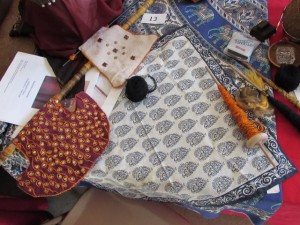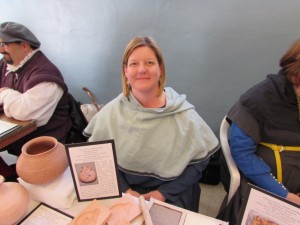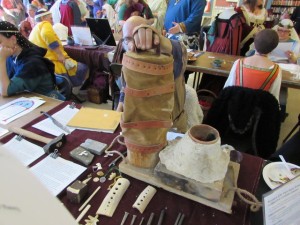2014 King’s and Queen’s Arts and Sciences
 February 22 dawned bright and clear as competitors, judges, and arts and sciences enthusiasts arrived for this year’s competition. There were 29 competitors this year, entering a wide range of projects, from sweets to swords, lace to illumination, and everything in between. Others came just to display their work and have a chance to share their crafts with like-minded people. The level of enthusiasm was high as both judges and populace visited the displays to talk to the participants about their research and workmanship. More than one judge commented on what a tough job they had because the level of work brought to the competition was so expertly done. In the end, only a few points separated the winners from the rest of the entries. Everyone left with new ideas about how to advance their work.
February 22 dawned bright and clear as competitors, judges, and arts and sciences enthusiasts arrived for this year’s competition. There were 29 competitors this year, entering a wide range of projects, from sweets to swords, lace to illumination, and everything in between. Others came just to display their work and have a chance to share their crafts with like-minded people. The level of enthusiasm was high as both judges and populace visited the displays to talk to the participants about their research and workmanship. More than one judge commented on what a tough job they had because the level of work brought to the competition was so expertly done. In the end, only a few points separated the winners from the rest of the entries. Everyone left with new ideas about how to advance their work.
This is just a small sampling of the arts and sciences work being undertaken by the members of the East Kingdom, with photos from the day. It was inspiring to be able to see the variety of interests being pursued.
Lady Katheryn Fontayne entered two 14th century style hoods. She not only sewed the hoods, but also dyed the fabric and crafted the bezants.

Yvan Wolvesbane was on hand with his hand-forged iron tools and a model of a period forge.

Lady Pakshalika Kananbala entered a range of projects all related to her Indian persona.

Lady Isabel de Roys demonstrated the various ways that clay was shaped in period, including molds, tiles, coil built and wheel thrown work.
Lorenzo Gorla brought research on fencing techniques.

Lady Elysabeth Underhill’s work on Anglo-Saxon beads included meticulous reproductions of beads found in Mucking, Castledyke and Buckland.

Lady Eleanor Atte Knolle’s entry included a 16th century Italian capputto, and her experimentation with metal thread bobbin lace to recreate period production methods.

Lady Judith bas Rabbi Mendel is researching all of the things associated with creating the Passover feast in period.

Lady Katrusha is researching the International Phoenetics Alphabet as a way to make early languages more accessible to heralds and others interested in foreign languages.
Photographs by Nicholas of Colechurch

